Aseptic Hand Hygiene: The Nail Pick Solution Reducing Single Use Plastic
Overview
Each year we supply over 2 million1 scrub brushes with dry sponge and nail pick pre-operative sets (product code FSL727) at a cost to the NHS of £364,314.
Raymond Pukacz our Clinical Engagement and Implementation Manager (CEIM) and the team responsible for Pre-Operative Skin Preparation framework met with Clinical Procurement Specialist Nurses (CPSN) from several trusts across the region. The meeting revealed that scrub brushes are often discarded and only the nail picks are used by clinicians.
This raised concerns about the financial and sustainable impacts of opening a sterile scrub brush set just to access the nail pick.

The Challenge
Guidance from the World Health Organisation (WHO) and the Association for Perioperative Practice (AfPP) recommends only the use of a nail pick for aseptic handwashing.
Scrub brushes bought as part of a set frequently ended up being thrown away, without any use. This not only had a financial impact (purchasing unused products) but also led to obvious environmental consequences and waste issues. This resulted in a significant amount of single use plastic entering the waste stream and added to the disposal costs.
Packaging issues
The scrub brush and nail pick set come in an outer cardboard case. The set comprises a scrub brush, made from Low Density Polyethylene (LDPE) plastic, with bristles on one side and a sponge on the reverse made from Polyurethane (PU) plastic.
It includes a nail pick made from Polyoxymethylene (POM) within the set, and the entire set comes in sterile packaging – 25 individually wrapped brushes are packaged inside an inner box, and there are 10 inner boxes per outer box, resulting in a significant amount of cardboard packaging.
The Solution
Our clinical team, through collaboration, strived to develop innovative and patient focussed solutions following the meeting with the CPSN’s. They brainstormed solutions that aligned with aseptic hand washing.
It was important to take into account guidance from hand washing guidelines and professional bodies including the AfPP, the WHO and Centres for Disease Control and Prevention (CDC).
We also wanted to include financial considerations and sustainable choices.
The solution involved introducing a stand-alone nail pick, and cutting down on single use plastic and cardboard packaging. This not only reduces carbon footprint but also proves to be cost-effective while adhering to aseptic hand hygiene standards.
The Results
We collaborated with suppliers and stakeholders to introduce a standalone nail pick that complies with aseptic hand hygiene guidelines. The new nail pick (product code FSL85039) underwent evaluation by the CPSN and their teams, receiving positive feedback.
It was found that this innovation would lead to significant cost savings and assist in following aseptic hand-washing guidelines. The nail pick, by itself, does not require sterilisation, leading to reduced packaging costs. Furthermore, it will assist each NHS organisation’s efforts to decrease carbon emissions and waste.
It’s crucial to involve the right individuals to drive change. We presented the nail pick to our Medical Devices Management Group for approval to trial following discussions with our Infection Prevention Control department and theatres who agreed to evaluate. The AfPP and WHO guidance, along with considerations of sustainability and cost savings, played a significant role in integrating this within the trust.
Amanda Price, Clinical Procurement Nurse at Shropshire Healthcare Procurement Service.
Switching opportunity
Based on all annual volumes switching from FSL727 to FSL85039 a potential savings of circa £204,0003 will be available to the NHS once the new framework for Pre Operative Skin Preparation starts on 3 June 2024.
Driving a Sustainable Choice
We will continue to support trusts by collaborating with suppliers and customers – and changing practices and behaviours to drive out carbon where we can.
The transition to the new solution uses hierarchy principles such as eliminating what clinicians do not need to use, and driving down usage overall.
If every trust that already purchases the sets switched to the nail pick only, there is potential to:
Reduce single use plastic usage by
30 tonnes
Reduce cardboard packaging by
15.86 tonnes
Avoid carbon emissions by
93.02 tonnes*
Reduce carbon emissions by
93%**
The CO2e calculations in the case study have been calculated using product code FSL727. There is an alternative product code FBF85016 with a similar specification, the potential for CO2e reductions is likely to be comparable given the similarity of these two nail picks although packaging may differ slightly.
* Plastic Scrub Brush 80.55 tonnes CO2e and Packaging 12.47 tonnes of CO2e.
**This is a 93% reduction when comparing the carbon emissions of the single nail pick to the carbon emissions of the set2.
Next Steps
Whilst the scrub brush and nail pick remain on our catalogue, it is hoped that NHS trusts will transition to the single nail pick solution, especially now that data on carbon impact and potential for plastic reduction has been shared.
Further to this, a saving opportunity will be available in mid-April 2024 during the six week customer launch of the new framework.
The scrub brush also remains a single item for alternative uses to aseptic hand hygiene.
| NHS Supply Chain Catalogue Product Code (NPC) | MPC | Description | Unit of Issue |
| FSL727 | NS5001 | Brush Scrub Pre-Operative Integral sponge dry with nail pick (sterile) | 25 (box) |
| FSL85039 | NSPICK/10 | Nail Picks non-sterile bulk back | 10 (bag) |
| FSL728 | NS5005 | Brush Scrub Pre-Operative Integral sponge dry without nail pick | 25 (box) |
References
1 Annual sales volume for the date range week commencing 16 April 2022 to the week ending 14 April 2023, on FSL727, was £2,143,025.
2 Carbon emission calculations use methodology from DEFRA GHG Conversation Factors 2023 procured materials Greenhouse gas reporting: conversion factors 2023 – GOV.UK (www.gov.uk).
Where the emission factor for specific plastic is not available from DEFRA, use the generic plastic emission factor.
3 Switching opportunity based on annual sales volumes from January 2023 to December 2023.
See our Downloads ▼ section for the PU plastic emission factor source we used. ( see page five Table 4: Global warming potential for the production of one kg).
Useful Links
-
NHS Supply Chain Sustainability Strategy - Delivering Health Sustainably
View our sustainability web pages here to keep up to date with all of our sustainability news.
-
Hospital Care Team
Contact our Hospital Care Team for further information on the project and more.
-
World Health Organization
2009 WHO Guidelines on Hand Hygiene in Health Care (revised Aug 2009).
-
Association for Perioperative Practice
2016 Standards and Recommendations for Safe Perioperative Practice 3rd edition Harrogate, AfPP
